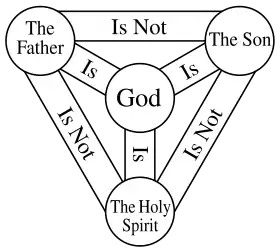Trinitarian formula
The Trinitarian formula is the phrase "in the name of the Father, and of the Son, and of the Holy Spirit" (original Greek: εἰς τὸ ὄνομα τοῦ Πατρὸς καὶ τοῦ Υἱοῦ καὶ τοῦ Ἁγίου Πνεύματος, eis to ónoma toû Patros kaì toû Huioû kai toû Hagíou Pneúmatos, Latin: ĭn nōmine Pătris ĕt Fīliī ĕt Spīritūs Sānctī), or words to that form and effect, referring to the three persons of the Christian Trinity. It is often followed by an "amen".

Biblical origin
These words are quoted from a command of the risen Jesus in the Great Commission: "Go, therefore, and make disciples of all nations, baptizing them in the name of the Father, and of the Son, and of the Holy Spirit" (Matthew 28:19); a small minority of other translations read, "into the name".[1]
Whereas some have argued that Matthew 28:19 was an interpolation on account of its absence from the first few centuries of early Christian quotations, scholars largely accept the passage as authentic due to its supporting manuscript evidence and that it does appear to be quoted in the Didache (7:1-3)[2] or at least reflected in the Didache as part of a common tradition from which both Matthew and the Didache emerged.[3]
Use in baptism
According to the doctrines of Roman Catholicism, Oriental Orthodoxy, Eastern Orthodoxy, and most forms of Protestantism, such as Lutheranism and Anglicanism, a baptism is not valid if the Trinitarian formula is not used in the administration of that sacrament. Consequently, they may not recognize religious communities that baptize without this formula – e.g. Unitarians, Branhamists, Frankists, Jehovah's Witnesses, and Oneness Pentecostals, all of whom deny the Trinity – as Christian religions. This is also the case with baptisms within The Church of Jesus Christ of Latter-day Saints (LDS church). Although LDS members baptize with the same Trinitarian formula, they reject the Nicene Trinitarian conception and regard the three persons of the Trinity as being distinct personages united not in substance, but in dominion and purpose.[4] Other faiths (Frankists, Oneness Pentecostals and Branhamists in particular) use the formula "In the name of Jesus Christ" (based on Acts 2:38) for baptism, and in turn re-baptize converts who were first baptized under the Trinitarian formula, sometimes claiming that such persons would not have been previously aware that "Jesus is the Lord".
Likewise, converts to Trinitarian denominations from Mormonism and other nontrinitarian denominations have to be baptized in the name of the (Nicene) Trinity.
Baptism according to the Trinitiarian formula, which is done in most mainstream Christianity, is seen as being a basis for Christian ecumenism, the concept of unity amongst Christians belonging to different Christian denominations.[5][6]
Other uses
Together with baptism, the Trinitarian formula is used in other prayers, rites, liturgies, and sacraments. One of its most common uses apart from baptism is when Roman Catholics, Eastern and Oriental Orthodox, Lutherans, Anglicans, Methodists, and others make the sign of the cross while reciting the formula.
Views of textual critics
Scholars have challenged the work of the Jesus Seminar, who state the verse is an extrapolation, arguing that those working on the project began with a conclusion and worked to justify it through their research and eisegesis.[7]
See also
References
- "English Standard Version (ESV) Footnote on Matthew 28:19". Retrieved 9 January 2014.
- Everett Ferguson, Baptism in the Early Church, 2013, 134-5
- Sim, David C., and Boris Repschinski, eds. Matthew and his Christian contemporaries. Bloomsbury Publishing, 2008, 124-5.
- Encyclopedia of Mormonism, Godhead, http://eom.byu.edu/index.php/Godhead
- Pizzey, Antonia (15 March 2019). Receptive Ecumenism and the Renewal of the Ecumenical Movement: The Path of Ecclesial Conversion. Brill Academic Publishers. p. 131. ISBN 978-90-04-39780-4.
Baptism into Christ unites all Christians, despite ther divisions. It is relationship with Christ through baptism, which enables relationship with other Christians. According to Congar, "on the basis of the baptism which incorporates us into Christ and the Word which is our Christian norm, [ecumenism's] aim is to carry out the will and the prayer of Christ, which is that his disciples should be united." The Christological foundation of Spiritual Ecumenism affirms that ecumenism is not our idea or goal, but rather Christ's will and prayer for us. Moreover, Christian unity already exists to some exent among all baptised Christians because of their relationship with Christ. Only through Christ is ecumenism possible. Kasper explains that Spiritual Ecumenism's fundamental Christological basis means that any ecumenical spirituality "will also be a sacramental spirituality." Baptism is "therefore a basic element of ecumenical spirituality."
- "Becoming a Christian: The Ecumenical Implications of Our Common Baptism". World Council of Churches. 24 January 1997. Retrieved 13 September 2020.
- They apply the Seminar's presuppositional test, "Beware of finding a Jesus entirely congenial to you", especially to the Jesus Seminar themselves, "who a priori have determined the nature of the 'historical Jesus' by adopting biased presuppositions, thereby producing a 'Jesus' wholly 'congenial' to themselves" (The Jesus Crisis: The Inroads of Historical Criticism Into Evangelical ..., by Robert L. Thomas, F. David Farnell); cf. A Look at the Jesus Seminar, by Brad Bromling, The Jesus Seminar and Radical Higher Criticism by Glenn Giles, etc.]